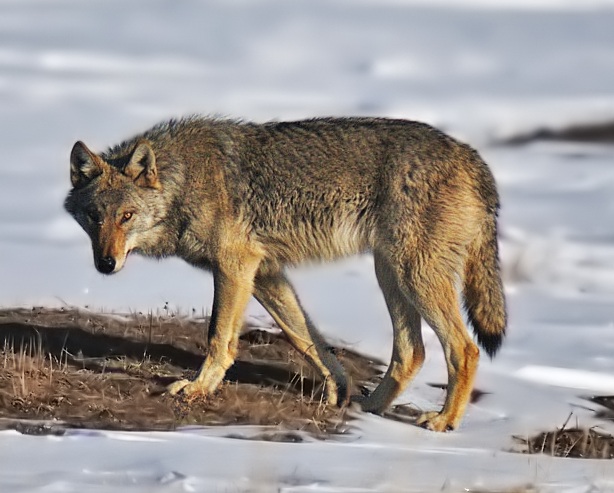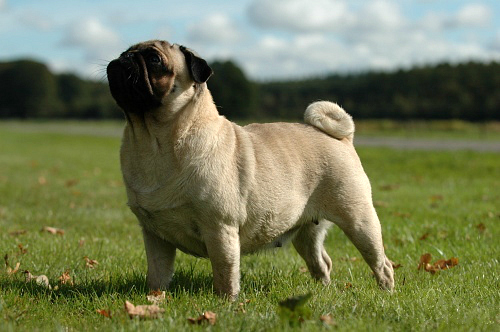We’ve finished talking about fossils and now we move to ‘presently observed nature weaknesses’ (I’m not even going to comment on the exceedingly poor wording.). What the Texas creationists have done is set up a system where each bit of evidence for evolution is considered individually and dismissed. Then, they claim that the entire theory has problems. As we shall see here, this causes them some problems.
Selective breeding has produced only very limited change with no new structures occurring over thousands of years and multitudes of generations of selection. This clearly demonstrates that there are natural limits to biological change. Examples: dogs, cattle, pigeons …
Selective breeding (or artificial selection)* was used by Darwin as an example of how evolution works. Evolution, remember, is nothing more than a change in the allele frequency of a population. When dog breeders have gone from this
to this
in just 10,000 years or so, I don’t see the problem. Look at what has changed in this animal. It is much smaller, much chunkier, the muzzle is shorter, floppy ears, curled tail, etc.
“Ah HA!” The creationist shouts. “But it’s still a dog.”
Is it really? This is an example of a cline or a ring species. Basically you start with a population (A) and near one edge of its range or feature is population B. Near the edge of population B is population C and so on. You have something that looks like this.
A – B – C – D – E – F – G – H
In this case, A is a gray wolf and H is a pug. Are the pug and wolf able to breed together without human assistance? Technically, I suppose yes. But, in practice, I think it would be problematic. A male pug just doesn’t have the stature to mount a female wolf. In either case, I think the wolf would be more likely to kill the pug than mate with it.
Are they different species? Species is such a problematic concept. We humans want to divide everything into neat little boxes, but reality just isn’t that way. Let’s say that we know for sure that animals in population A and animals in population H cannot interbreed. But A can interbreed with B and maybe C. C can definitely interbreed with B and D, maybe A and E. Etc. until G can definitely interbreed with H and F and maybe E. But we know that, for whatever reason, A and H cannot.
Are A and H different species? If so, where do we draw the dividing line between the species? Anywhere we draw that line will be separating two populations that can interbreed.
Are A and H the same species? If so, then the biological species concept is useless (which it really pretty much is anyway).
So, instead we look at the evolutionary history of the organism. Now this isn’t a case of us using evolution to prove evolution. The theory of evolution predicts that the more closely related two populations are, then the more likely they will be able to interbreed. By interbreeding here, we mean not only have offspring, but have grandchildren. Horses and donkeys can interbreed, but mules are sterile.
No one doubts that there are limits to evolution. It is not possible to breed cats and have them turn into pigs.
Evolution, unlike a designer, only has the genetic history of the organism to work with. Which explains a lot of the problems that modern humans face. Hernias are the result of a hole in our body lining to let testicles through. This issue can be traced all the way back to the common ancestor of us and modern sharks.
Part of this creationist concern is simply that we humans haven’t existed long enough. It’s like planting a tree in your yard. Month after month, you don’t really notice any change. Then, 15 years later, you realize how big that tree has gotten. Look at Lenski’s work. It took nearly twenty years for a major event to happen.
Evolution tends to be very slow changes over hundreds of generations. Sometimes, the population remains stable and those minor changes result in a new population. Sometimes, in just a few generations, speciation can occur.
That’s why we look at the fossil history of a group of animals. Fossils give us a way to compress time, if you will. We can see, in just a few layers, the massive changes that took place over millions of years. The evolution of cetaceans is an excellent example of this.
- Pakicetid : 55.8 – 40.4 mya – the first cetaceans. These land dwelling hooved animals are classified as whales by the presence of three unique features found only in whales.
- Ambulocetus natans : 49 mya – the first (maybe) cetacean that could swim as well as walk on land. Think of it like a mammal alligator. Notice the time line of this organism overlaps that of the Pakicetids. We don’t know which organisms were direct ancestors or that kind of thing. But the same features in the Pakicetids are present in A. natans and in a slightly more advanced form. Minor incremental changes in those features, combined with other changes. It’s skeletal system was more adapted for swimming than walking.
- Remingtonocetidae: 55.8 – 48.6 mya – this family of animals shows many adaptations to an aquatic existence. They could move on land, but not nearly as well as the other two. Most of the fossils were found in association with catfish and crocodiles. At least one species lived in a marine environment. At least some of these species possibly no longer required land (like the modern sea otters).
- Protocetids: 48 – 35 mya – another large group of cetaceans. While they remain amphibious, they were even more adapted to life in the water.
- Basilosaurids and Dorudontinae: 41 – 35 mya – These were both purely aquatic groups. Recent evidence suggests that the Basilosaurids were not ancestral to modern whales, but the Dorudontinae very well might have been. The next step are the modern cetaceans with echolocation.
- Squaladon: 33-14 mya – The first cetacean that has evidence of echolocation. A modern toothed-whale.
_____________________
* I actually prefer the phrase ‘selective breeding’ to the more common ‘artificial selection’. There’s nothing artificial about selection except for the fact that it it human directed instead of environmentally directed.


